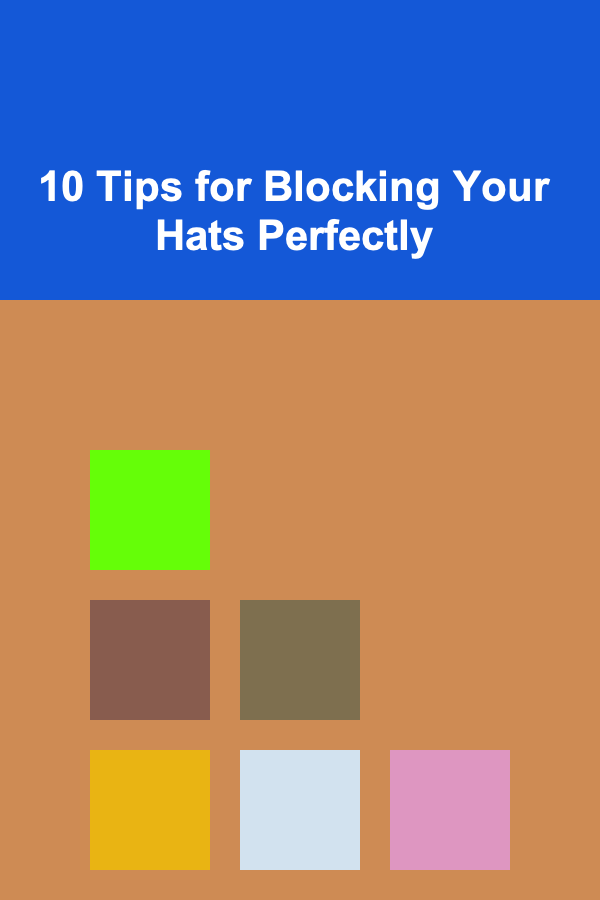
10 Tips for Blocking Your Hats Perfectly
ebook include PDF & Audio bundle (Micro Guide)
$12.99$5.99
Limited Time Offer! Order within the next:

Hat blocking is the process of shaping and forming a hat to fit the desired style and structure, often involving the use of specialized forms or blocks. Whether you are a seasoned hat maker or a beginner, learning how to block your hats perfectly is a vital skill for producing high-quality, well-structured hats. This article will guide you through 10 essential tips for blocking hats with precision and expertise.
Choose the Right Hat Block
The first step to perfect hat blocking is selecting the correct hat block for the style you are aiming to create. A hat block is a mold that allows the fabric or felt to take shape during the blocking process. They come in various shapes, sizes, and styles, such as fedora, bowler, cloche, and more.
Key Considerations When Choosing a Hat Block:
- Shape: Ensure the block you choose matches the shape and style of the hat you are creating. For example, a fedora block will provide the iconic pinch in the crown, while a cloche block will offer a rounded, smooth shape.
- Size: Make sure the block is the correct size for the head it is meant to fit. A block that's too small or large will result in an ill-fitting hat.
- Material: Most hat blocks are made of wood, but they can also be found in plastic, metal, or even silicone. Wood is the most traditional and offers the best support for wool felt and straw hats.
A high-quality block will ensure that your hat has a smooth, consistent shape and that it retains its form over time.
Prepare the Hat Fabric
Before you start blocking, you must prepare your hat fabric or felt. The type of material you are using will influence how you block the hat, and it's essential to treat the fabric correctly to achieve the desired finish.
Tips for Preparing Your Hat Fabric:
- Steam: For wool felt or straw, steaming helps soften the fibers, making them more pliable and easier to mold. Hold the fabric over a steaming kettle or use a garment steamer to moisten the fabric.
- Shape the Fabric: Once the fabric is steamed, gently stretch and pull it over the block to match the intended shape. Be mindful not to distort the fabric.
- Trim Excess Fabric: If necessary, trim any excess material from the edges of the hat once it's stretched over the block. This will ensure that the fabric fits neatly on the block.
Proper fabric preparation is crucial for achieving smooth, wrinkle-free results in your final hat.
Use the Right Blocking Tools
Having the right tools for blocking your hats is essential for achieving a professional finish. Some of the most common blocking tools include:
Essential Blocking Tools:
- Hat Stretcher: A hat stretcher helps expand the fabric and ensures the hat will fit comfortably around the head. It's especially useful for reshaping or enlarging a hat.
- Steam Iron: A steam iron is useful for adding steam to the fabric to soften it before blocking, especially when working with felt materials.
- Pinning Tools: Hat pins or tacking pins can be used to secure the fabric to the block while it dries, ensuring it retains its shape.
These tools help you maintain control over the fabric and ensure that it stays in place during the blocking process.
Pin the Fabric Properly
Once the fabric is on the block, it's crucial to pin it in place properly. This step ensures that the fabric stays tight against the block and doesn't slip or shift while it dries.
Pinning Tips:
- Use Hat Pins: Hat pins are long, thin pins that are specifically designed for pinning fabrics in the blocking process. These pins allow for precise placement without damaging the fabric.
- Work in Small Sections: Start pinning at one part of the hat and gradually work around the edges, pinning small sections at a time. This will help distribute tension evenly and ensure the fabric stays smooth.
- Avoid Over-Pinning: Don't overuse pins, as this can create unwanted creases or marks in the fabric. Pin the fabric just enough to hold it securely in place.
Proper pinning ensures that your hat takes on the correct form without unsightly wrinkles or misalignments.
Control the Drying Process
Drying is one of the most critical parts of the hat blocking process. If the fabric dries too quickly or unevenly, it can lead to an uneven shape or distortions in the final product.
Drying Tips:
- Air Drying: For most hats, it's best to allow them to air dry on the block. This ensures that the fabric dries evenly and maintains its shape.
- Drying Time: Be patient and allow enough time for the hat to fully dry. For wool felt or straw hats, drying can take anywhere from 12 to 24 hours, depending on the material and the humidity level in the environment.
- Avoid Direct Heat: Do not use direct heat sources like blow dryers or heaters, as they can cause the fabric to dry too quickly and lose its shape.
Ensuring a slow and even drying process is key to achieving a perfectly blocked hat.
Shape the Brim Separately
In many hat styles, the brim requires separate shaping from the crown. This is especially true for wide-brimmed hats or floppy hats. Shaping the brim ensures that it maintains its structure and holds its desired shape.
Brim Shaping Tips:
- Steam the Brim: Just like the crown, steam the brim to soften the fabric. Use a steam iron or a steaming kettle to add moisture to the brim area.
- Pin the Brim: Pin the brim to the edge of the block or use a separate brim-shaping form to mold the brim. Ensure that the pins are placed evenly around the brim to avoid warping.
- Avoid Over-Stretching: Be careful not to over-stretch the brim while shaping it, as this can cause it to lose its natural curve.
Shaping the brim with precision will help you achieve a clean, professional look in your final hat.
Monitor the Fabric Tension
While blocking your hat, it's important to keep an eye on the tension of the fabric. If the fabric is too tight, it may cause unwanted creases or distortions, while too much slack can lead to an uneven shape.
Tips for Managing Fabric Tension:
- Stretch Evenly: As you pull the fabric over the block, do so evenly and carefully to avoid creating tension in one area. This will help maintain a smooth, uniform appearance.
- Use the Hat Stretcher: If needed, use a hat stretcher to adjust the tension and ensure that the fabric fits snugly and evenly around the block.
- Smooth Out Wrinkles: If you notice any wrinkles during the blocking process, gently smooth them out by stretching the fabric or adding steam.
Keeping the fabric at an even tension will help you avoid wrinkles and ensure that the hat maintains its intended shape.
Apply a Finish to Set the Shape
Once the hat has dried and taken on its shape, applying a finish will help set the form and give the hat a polished appearance. The finish also helps protect the fabric and make it more durable.
Types of Finishes:
- Hat Stiffeners: A stiffener can be applied to the fabric to ensure that the hat maintains its structure and doesn't lose its shape over time.
- Waterproofing Spray: For hats exposed to outdoor elements, consider applying a waterproofing spray to protect the fabric from moisture and wear.
- Hat Cleaner: After blocking, clean the hat's surface using a soft brush or fabric cleaner to remove any dust or residue from the blocking process.
Applying a finish helps extend the life of your hat and keeps it looking great.
Check the Fit and Adjust
Once the hat is blocked and dried, it's time to check the fit. A perfectly blocked hat should fit the head comfortably without being too tight or too loose.
Fit Adjustment Tips:
- Try the Hat On: Carefully place the hat on a head form or a willing volunteer to check its fit. If it's too tight, use a hat stretcher to enlarge the hat. If it's too loose, try adding some felt or padding inside the band.
- Adjust the Crown and Brim: If the crown or brim is misshapen, gently reshape it with your hands or reapply steam to adjust the fabric.
Making adjustments after blocking ensures that the hat fits properly and looks its best.
Practice and Patience
Blocking hats is an art form that takes time and practice to master. Each material reacts differently, and different styles require specific techniques. Don't be discouraged if your first few hats aren't perfect---each attempt provides valuable experience.
Tips for Continued Success:
- Experiment with Different Materials: Try blocking different types of fabrics, including felt, straw, and fabric, to understand how each one behaves during the blocking process.
- Learn from Mistakes: If you make a mistake or the hat doesn't turn out as expected, take notes on what went wrong and use that knowledge to improve on future projects.
- Be Patient: Blocking a hat takes time, and rushing through the process can result in poor results. Take your time with each step to achieve the best possible outcome.
With practice and patience, you'll become skilled at blocking hats perfectly every time.
Conclusion
Hat blocking is a crucial skill for anyone looking to create high-quality, well-structured hats. By selecting the right block, preparing the fabric properly, using the correct tools, and following these essential tips, you can create hats that are both beautiful and durable. Whether you are blocking a simple cap or an elaborate wide-brimmed hat, these tips will help you achieve a perfect finish every time.
Reading More From Our Other Websites
- [Personal Investment 101] How to Use Your Deep Learning Skills to Build a Profitable Side Hustle
- [Personal Care Tips 101] How to Apply Concealer for a Natural Look
- [Organization Tip 101] How to Conduct a Seasonal Inventory Check
- [Personal Care Tips 101] How to Create an Eco-Friendly Personal Care Routine
- [Personal Care Tips 101] How to Refresh Your Skin with Body Spray During the Summer Heat
- [Organization Tip 101] How to Choose Eco-Friendly Flooring Materials for Your Renovation
- [Personal Finance Management 101] How to Cut Unnecessary Expenses and Boost Your Savings
- [Home Storage Solution 101] How to Use Multi-Functional Furniture for Extra Storage Space
- [Home Party Planning 101] How to Plan a Multi-Generational Party: Activities and Ideas for All Ages
- [Home Storage Solution 101] How to Organize Your Kids' Closet with Clever Storage Hacks

How to Create a Bright and Cheerful Kitchen with Lighting
Read More
Making the Switch: Tips for Successfully Using Cash Instead of Credit Cards
Read More
Mastering Data Engineering: A Comprehensive Guide to Modern Data Processing
Read More
The Operations Supervisor's Playbook: Best Practices for Streamlined Operations
Read More
Understanding Reincarnation in Mythology: A Deep Dive
Read More
How to Create a Chore Chart for Shared Living Spaces
Read MoreOther Products

How to Create a Bright and Cheerful Kitchen with Lighting
Read More
Making the Switch: Tips for Successfully Using Cash Instead of Credit Cards
Read More
Mastering Data Engineering: A Comprehensive Guide to Modern Data Processing
Read More
The Operations Supervisor's Playbook: Best Practices for Streamlined Operations
Read More
Understanding Reincarnation in Mythology: A Deep Dive
Read More